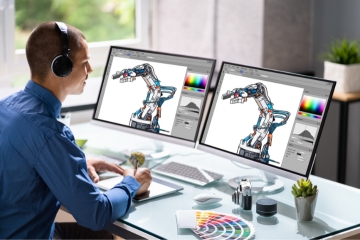
The Function of CSS in Contemporary Web Design
The Critical Role of CSS in Contemporary Web Design
In the rapidly evolving digital landscape, CSS (Cascading Style Sheets) has emerged as a foundational element in modern web development. CSS is not merely a tool for adding style to web pages; it is integral to shaping the overall aesthetics, functionality, and user experience of websites. For web designers and developers, mastering CSS is crucial to creating responsive, dynamic websites that can effectively meet the diverse needs of users across multiple devices. At V1 Academy we emphasize practical, hands-on training in web technologies, with a focus on CSS as a fundamental building block of web design and development.
The Evolution of CSS in Web Development
When the web was in its infancy, websites were predominantly static, consisting of basic HTML structures. These early websites offered limited functionality and lacked the design sophistication that users now expect. As the web grew in complexity and user expectations increased, the need for a more robust way to style and layout web pages became apparent. This is where CSS made its mark.
CSS was introduced in the late 1990s to provide developers with a way to separate content (HTML) from presentation (design and layout). This separation allowed for greater flexibility and consistency in website design. Developers could now create a single CSS file that controlled the appearance of an entire website, rather than repeating the same style rules in each HTML file. This modular approach not only streamlined the development process but also made it easier to maintain and update websites.
Over time, CSS has evolved from a simple styling language into a powerful technology capable of handling complex layouts, animations, and interactions. The introduction of CSS3 brought a wealth of new features, including transitions, transformations, and advanced layout techniques like flexbox and grid. These advancements have allowed developers to create visually appealing, interactive websites while maintaining control over performance and accessibility. At V1 Academy, we ensure that our students understand the full journey of CSS, from its early days to its current state as a cornerstone of modern web development.
The Power of Modern CSS: Transitions, Transformations, and Layouts
One of the most significant advancements in CSS has been the introduction of CSS3, which expanded the language’s capabilities far beyond simple styling. With CSS3, developers gained access to powerful tools for creating animations, transitions, and dynamic layouts, all of which contribute to a more engaging user experience.
Transitions and Animations: Transitions in CSS allow developers to animate changes in an element's properties over time. This means that instead of a change happening instantly, it can occur gradually, adding a sense of fluidity to the website. For example, a button can change color or size smoothly when hovered over, providing visual feedback that enhances the user experience. CSS animations take this concept further by enabling developers to create complex sequences of movements and transformations, such as rotating elements, fading in or out, or even moving objects along a defined path.
Flexbox and Grid Layouts: Flexbox and grid are two of the most important layout systems introduced in CSS3. Flexbox is designed for laying out items in a one-dimensional space—either in a row or a column. It makes it easy to align elements, distribute space within a container, and adapt layouts to different screen sizes. Grid, on the other hand, is a two-dimensional layout system that allows developers to create complex layouts with ease. With CSS Grid, you can define both rows and columns, giving you precise control over the placement of elements. These tools are essential for building responsive websites that work seamlessly across a variety of devices.
At V1 Academy, we ensure that our students not only learn these techniques but also understand how to use them effectively in real-world projects. This hands-on approach equips our graduates with the skills they need to design and develop websites that are not only visually appealing but also optimized for performance and accessibility.
CSS Frameworks and Libraries: Streamlining Web Development
As web applications have grown in complexity, so too has the need for tools that can streamline the development process. This is where CSS libraries and frameworks are useful.
These tools provide pre-designed components and layout systems that can significantly speed up the development process, allowing developers to focus more on the creative aspects of design.
CSS Frameworks: Frameworks like Bootstrap, Foundation, and Bulma are widely used in modern web development. These frameworks offer a collection of pre-styled components—such as buttons, forms, navigation bars, and grids—that can be easily customized to fit the specific needs of a project. One of the key benefits of using a framework is that it provides a consistent design system, which helps ensure that all elements of a website work well together. Additionally, these frameworks are designed with responsiveness in mind, making it easier to create websites that look great on any device.
CSS Libraries: In addition to frameworks, CSS libraries like Animate.css and Hover.css provide a quick and easy way to add interactive and animated elements to a website. These libraries are collections of pre-written CSS code that can be applied to elements with minimal effort. For example, Animate.css offers a variety of animations, from simple fades and slides to more complex bouncing and flipping effects. Hover.css focuses specifically on hover effects, allowing developers to create engaging, interactive experiences without writing extensive custom code.
At V1 Academy, we integrate the use of these frameworks and libraries into our curriculum. Our students gain practical experience in using these tools to build responsive, interactive websites efficiently. By learning how to leverage frameworks and libraries, our students are able to speed up their development process while still maintaining a high level of design flexibility and creativity.
Responsive Design: A Fundamental Requirement in Modern Web Development
In today’s mobile-first world, responsive design is not just an option—it is a necessity. With the increasing variety of devices and screen sizes, websites must be able to adapt seamlessly to different environments. CSS plays a crucial role in enabling responsive design, ensuring that websites provide a consistent and optimized user experience regardless of the device being used.
Media Queries: One of the most important tools for creating responsive designs in CSS is the media query. Media queries allow developers to apply different styles based on the characteristics of the user’s device, such as its screen width, height, orientation, and resolution. For example, a website might use a media query to apply a different layout for screens that are less than 768 pixels wide, ensuring that the content is easily readable on a smartphone. This flexibility is key to creating websites that work well on a wide range of devices, from small mobile screens to large desktop monitors.
Flexbox and Grid in Responsive Design: Flexbox and CSS Grid also play a significant role in responsive design. Their ability to create flexible, scalable layouts makes it easier to design websites that adapt to different screen sizes and orientations. For instance, a website layout might use flexbox to stack elements vertically on a narrow screen and arrange them horizontally on a wider screen. CSS Grid can be used to create more complex layouts that rearrange themselves based on the available space. These tools are essential for building modern, responsive websites that deliver a seamless user experience.
At V1 Academy, we prioritize teaching responsive design techniques in our courses. Our students learn how to use media queries, flexbox, and grid layouts to create websites that are not only visually appealing but also functional and accessible on any device. This hands-on training ensures that our graduates are well-equipped to meet the demands of today’s mobile-first web development landscape.
The Future of CSS in Web Development
The function of CSS will continue to change as web development does. New features and specifications are constantly being added to the CSS language, enabling developers to create even more sophisticated and dynamic web experiences. For example, CSS variables (custom properties) are becoming increasingly popular for managing design systems, allowing developers to define reusable values for colors, fonts, spacing, and more. Similarly, new layout modules like CSS Subgrid are being introduced to provide even greater control over complex designs.
At V1 Academy, we stay at the forefront of these developments, continuously updating our curriculum to reflect the latest trends and technologies in CSS. We believe that by providing our students with a deep understanding of CSS and its role in web development, we are preparing them to succeed in a rapidly changing industry. Whether they are building simple static websites or complex web applications, our graduates have the skills and knowledge to create designs that are both beautiful and functional, optimized for performance, accessibility, and responsiveness across all devices.
Conclusion
CSS is much more than a tool for styling websites—it is a fundamental technology that shapes the way we experience the web. From its origins as a simple styling language to its current role as a powerful tool for creating responsive, dynamic web designs, CSS has become an essential component of modern web development. At V1 Academy, we recognize the importance of CSS in today’s digital landscape, and we are committed to providing our students with the knowledge and skills they need to master this critical technology. By understanding the evolution of CSS, learning how to use modern layout techniques and frameworks, and prioritizing responsive design, our students are well-prepared to create websites that meet the needs of today’s users while staying ahead of the trends in web development.

He Laughed at My Computer Skills—Now He Asks Me for Help!

Warning: Skipping These PHP Tricks Might RUIN Your Web Development Career!

Instagram Likes Won’t Pay Your Bills—But This Digital Skills Will!

Your Brain Is Screaming for an Upgrade—Are You Ready for It?

From Beginner to Expert: How Basic Computer Skills Can Open New Opportunities

I Was Lost in My Career Until I Found Digital Marketing- Here's How it Transformed Me

Breaking the Middle-Class Mindset: Yes, Graphic Design Can Be a High-Paying Career

Breaking the ‘Non-IT Background’ Barrier: How Anyone Can Become a Developer with the Right Guidance

Graphic Design for Real-World Impact: Learn How to Build Apps, Brands, and Your Dream Career

Code Your Way to Confidence: How Programming Courses in West Bengal Are Giving Youngsters a Sense of Purpose

From Villages to Cities: How Basic Computer Courses Are Uniting and Empowering West Bengal

Break the 9-to-5 Cycle: Learn Digital Marketing and Create Your Own Path to Success in West Bengal